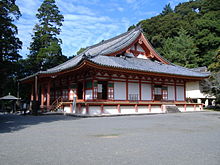Kanshin-ji
The Kanshin-ji ( Japanese 歓 心 寺 ) is a temple of the Shingon direction of Buddhism in the mountains on the eastern edge of the city of Kawachinagano ( Osaka prefecture ).
history
According to tradition, the temple was built in 701 by En no Ozuno ( 役 小 角 ) with the name Unshin-ji ( 雲 心 寺 ). In 808 Priest Kūkai came here to avoid bad providence and built seven Star Mounds of the Big Dipper for their worship. In 815 he made the Nyoirin-Kannon and gave the temple the name Kanshin-ji. His great student Jichie ( 実 恵 ) laid out the temple grounds with his buildings with his student Shinshō ( 真 昭 ). Around the year 836, the temple owned 1,500 Chōbu ( 町 ) and almost 1,500 hectares of forest and fields in Ishikawa County.
From the middle Kamakura period , the temple belonged to Daikaku-ji , and at the time of Namboku-chō , the temple became the prayer temple of the local Tennō . So the sub-temple Sōji-in ( 総 持 院 ) served from 1359 as a kind of secondary residence ( 行在 所 anzaisho ) for Emperor Go-Murakami . It is believed that the Sōji-in was where there is now a pond. A memorial stone on the edge of the pond reminds of this. Relations with the temple were also close to the Kusunoki clan, which was loyal to the emperor.
The attachment
The temple complex is the oldest within Osaka Prefecture and the only one within the Minamikawauchi area that has national treasures. The temple was built on the southern slope of a hill above a brook valley and is accessed by stairs.
The main building is the main hall. It dates from the Heian period , but its external design dates from around 1334. It is almost square with a side length of 20 × 18 m. It is surrounded by a number of smaller buildings, including the low bell tower ( 鐘 堂 shōdō ). Halfway up is the abbot's quarters ( 本 坊 honbō ), up on the western edge the treasure house ( 霊 宝 館 Reihō-kan ).
Treasures of the temple
National treasures
- Today's main hall ( 金堂 kondō ) dates from the 14th century and is registered as a national treasure. It combines structural elements of the various architectural styles and is considered the best example of the "mixed style" ( 折衷 様 setchū-yō ) in Japanese temple construction.
- The Nyoirin Kannon ( 如意輪 観 音 ), 12th century, also a national treasure , is shown seated here. It is not made from a block, but composed of pieces of wood ( 寄 木造 yoseki zukuri ) and is hollow on the inside. The original setting and the decoration with gold foil ( 切 金 kirikane ) can still be seen in some places. The crown and base (except for the lotus flower) are later additions. The Nyoirin Kannon (Sanskrit: Cintāmaṇic-akra) is usually depicted with six arms, which symbolize the wealth of her graces. In one of her left hands she holds up the “wheel of the law” (Sanskrit: dharmacakra ). The statue is only opened to the public on April 17th and 18th each year. - Despite its status as a national treasure, this Kannon was exceptionally exhibited in 1939 as part of the “Exhibition of Old Japanese Art” in Berlin.
- History of the origin of the temple ( 観 心 寺 縁 起 資財 帳 Kanshinji engi shizai chō ).
Important cultural assets
The temple's important cultural assets include:
- the protective shrine ( 鏡 守 堂 Chinju-dō ), also called Kariteiboten-dō ( 訶 梨 帝 母 天堂 ), is a small shrine 1 Ken wide (1.80 m) in the Kasuga style, with a sweeping roof, the one with thin Cypress shingles ( 檜 皮 葺 hiwada-buki ) is covered. The shrine stands for the protection of the temple by the Shinto deities. The current building dates from the Momoyama period .
- the Unfinished Pagoda ( 立 掛 塔 Tatekake-tō ) was started by Kusunoki Masashige , but remained unfinished because of his death.
Others
- On the temple grounds around the main hall there are seven mounds of earth ( 星 塚 seizuka ) created by Kūkai , which symbolize the seven stars of the Great Bear.
- The grave of Kusunoki Masashige, who fought for the south courtyard at the time of the split in the imperial house in the 14th century, is located on top of the temple grounds. Masashige is also honored there with an equestrian monument at the entrance.
literature
- Osaka-fu no rekishi sampo henshu iinkai (ed.): Kanshin-ji. In: Osaka-fu no rekishi sampo (ge) . Yamakawa Shuppan, 2007, ISBN 978-4-634-24827-4 , pp. 207-209.
Web links
- Page of the temple (PDF; Japanese, English)
Individual evidence
- ↑ Mainichi Shimbun (ed.): Jubun bunkazai 12. Kenzobutsu I. S. 112. Mainichi Shimbun, 1973.
- ↑ Staatliche Museen, Berlin (ed.): Exhibition of Old Japanese Art . Verlag für Kunstwissenschaft Berlin, Berlin 1939, p. 13.
Coordinates: 34 ° 26 '14.4 " N , 135 ° 35' 54.9" E



